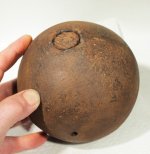42 Scout car
Greenie
- Nov 15, 2021
- 17
- 10
This is not mine but just trying to learn about cannonballs. The seller claims that it is a 18 pounder. The ball is on Ebay. The tables seem to confirm that it is a 18lbs. Can I get an expert to confirm this? Thanks. The gents writes:
THIS IS A 5" (+/- MEASURED WITH AN ADJUSTABLE
TRI-SQUARE)
CAST IRON CANNON BALL
WEIGHS 14 POUNDS 9 OUNCES
AN "18 POUNDER"
SIZE AND WEIGHT IS WHAT WAS USED
IN BOTH THE REVOLUTIONARY WAR AND THE
WAR OF 1812 BY BRITISH AND FRENCH GUNS
HAS A 1 1/8" HOLE WITH WOOD PLUG
HAS TWO HOLES THAT WERE FROM THE CASTING
PROCESS: THE FILLING SPRUE WHICH IS THE SMALL HOLE
AND THE LARGE HOLE FOR THE PLUG
NOTE THE SEAM
DUE TO THE WEIGHT, I'M ASSUMING THIS BALL IS FILLED
WITH SHOT, EITHER IRON OR LEAD. NOT GOING TO
DESTROY THE PLUG TO FIND OUT!
THIS IS A 5" (+/- MEASURED WITH AN ADJUSTABLE
TRI-SQUARE)
CAST IRON CANNON BALL
WEIGHS 14 POUNDS 9 OUNCES
AN "18 POUNDER"
SIZE AND WEIGHT IS WHAT WAS USED
IN BOTH THE REVOLUTIONARY WAR AND THE
WAR OF 1812 BY BRITISH AND FRENCH GUNS
HAS A 1 1/8" HOLE WITH WOOD PLUG
HAS TWO HOLES THAT WERE FROM THE CASTING
PROCESS: THE FILLING SPRUE WHICH IS THE SMALL HOLE
AND THE LARGE HOLE FOR THE PLUG
NOTE THE SEAM
DUE TO THE WEIGHT, I'M ASSUMING THIS BALL IS FILLED
WITH SHOT, EITHER IRON OR LEAD. NOT GOING TO
DESTROY THE PLUG TO FIND OUT!





